Curing, Properties and EMI Absorption Shielding of Rubber Composites Based on Ferrites and Carbon Fibres
Abstract
:1. Introduction
2. Experimental
2.1. Materials
2.2. Methods
2.2.1. Fabrication and Curing of Rubber Compounds
2.2.2. Determination of Curing Characteristics
- ML—minimum torque (dN.m)
- MH—maximum torque (dN.m)
- ∆M (dN.m)—torque difference, the difference between MH and ML
- tc90 (min)—optimum curing time that corresponds to torque Mc90:Mc90 = ML + 0.9∆M
- ts1 (min)—scorch time
- R (dN.m.min−1)—curing rate, defined as:
- Mc90—torque at tc90
- Ms1—torque at ts1
2.2.3. Investigation of Mechanical Characteristics
2.2.4. Investigation of Shielding Characteristics
3. Results and Discussion
3.1. Curing Process of Rubber Compounds
3.2. Absorption Shielding Performance of Composites
3.3. Physical–Mechanical Properties of Composites
4. Conclusions
Author Contributions
Funding
Institutional Review Board Statement
Data Availability Statement
Conflicts of Interest
References
- Shukla, V. Review of electromagnetic interference shielding materials fabricated by iron ingredients. Nanoscale Adv. 2019, 1, 1640–1671. [Google Scholar] [CrossRef] [PubMed]
- El Sayed, W.; Lezynski, P.; Smolenski, R.; Moonen, N.; Crovetti, P.; Thomas, D.W.P. The effect of EMI generated from spread-spectrum-modulated SiC-based buck converter on the G3-PLC channel. Electronics 2021, 10, 1416. [Google Scholar] [CrossRef]
- Apakuppakul, S.; Methachittiphan, N.; Apiyasawat, S. Effect of electromagnetic interference from smartphone on cardiac implantable electronic device (EMI-PHONE study). J. Arrhythm. 2022, 38, 778–782. [Google Scholar] [CrossRef] [PubMed]
- Wang, J.; Wang, H.; Sun, Z. Research on the effectiveness of deep convolutional neural network for electromagnetic interference identification based on I/Q data. Atmosphere 2022, 13, 1785. [Google Scholar] [CrossRef]
- Okechukwu, C.E. Effects of radiofrequency electromagnetic field exposure on neuro-physiology. Adv. Hum. Biol. 2020, 10, 6–10. [Google Scholar] [CrossRef]
- Razek, A. Biological and medical disturbances due to exposure to fields emitted by electromagnetic energy devices—A review. Energies 2022, 15, 4455. [Google Scholar] [CrossRef]
- Hwang, J.H.; Kang, T.W.; Kwon, J.H.; Park, S.O. Effect of electromagnetic interference on human body communication. IEEE Trans. Electromagn. Compat. Energ. 2017, 59, 48–57. [Google Scholar] [CrossRef]
- Jeon, Y.J.; Yun, J.H.; Kang, M.S. Analysis of electromagnetic shielding properties of a material developed based on silver-coated copper core-shell spraying. Materials 2022, 15, 5448. [Google Scholar] [CrossRef]
- Wang, X.X.; Zhang, M.; Shu, J.C.; Wen, B.; Cao, W.Q.; Cao, M.S. Thermally-tailoring dielectric “genes” in graphene-based heterostructure to manipulate electromagnetic response. Carbon 2021, 184, 136–145. [Google Scholar] [CrossRef]
- Vovchenko, L.; Matzui, L.; Oliynyk, V.; Milovanov, Y.; Mamunya, Y.; Volynets, N.; Plyushch, A.; Kuzhir, P. Polyethylene composites with segregated carbon nanotubes network: Low frequency plasmons and high electromagnetic interference shielding efficiency. Materials 2020, 13, 1118. [Google Scholar] [CrossRef] [Green Version]
- Raagulan, K.; Braveenth, R.; Kim, B.M.; Lim, K.J.; Lee, S.B.; Kim, M.; Chai, K.Y. An effective utilization of MXene and its effect on electromagnetic interference shielding: Flexible, free-standing and thermally conductive composite from MXene–PAT–poly(p-aminophenol)–polyaniline co-polymer. RSC Adv. 2020, 10, 1613. [Google Scholar] [CrossRef]
- Singh, R.; Kulkarni, S.G. Nanocomposites based on transition metal oxides in polyvinyl alcohol for EMI shielding application. Polym. Bull. 2014, 71, 497–513. [Google Scholar] [CrossRef]
- Bayat, M.; Yang, H.; Ko, F. Effect of iron oxide nanoparticle size on electromagnetic properties of composite nanofibers. J. Compos. Mater. 2018, 52, 1723–1736. [Google Scholar] [CrossRef]
- Radoń, A.; Hawełek, Ł.; Łukowiec, D.; Kubacki, J.; Włodarczyk, P. Dielectric and electromagnetic interference shielding properties of high entropy (Zn, Fe, Ni, Mg, Cd) Fe2O4 ferrite. Sci. Rep. 2019, 9, 20078. [Google Scholar] [CrossRef]
- Sanida, A.; Stavropoulos, S.G.; Speliotis, T.; Psarras, G.C. Investigating the effect of Zn ferrite nanoparticles on the thermomechanical, dielectric and magnetic properties of polymer nanocomposites. Materials 2019, 12, 3015. [Google Scholar] [CrossRef]
- Huang, Y.; Chen, M.; Xie, A.; Xu, X. Recent advances in design and fabrication of nanocomposites for electromagnetic wave shielding and absorbing. Materials 2021, 14, 4148. [Google Scholar] [CrossRef] [PubMed]
- Katheria, A.; Nayak, J.; Das, N.C. A journey of thermoplastic elastomer nanocomposites for electromagnetic shielding applications: From bench to transitional research. Mater. Adv. 2022, 3, 2670. [Google Scholar] [CrossRef]
- Kruželák, J.; Kvasničáková; Hložeková, K.; Hudec, I. Progress in polymers and polymer composites used as efficient materials for EMI shielding. Nanoscale Adv. 2021, 3, 123. [Google Scholar] [CrossRef]
- Mo, Z.; Yang, R.; Lu, D.; Yang, L.; Hu, Q.; Li, H.; Zhu, H.; Tang, Z.; Gui, X. Lightweight, three-dimensional carbon Nanotube@TiO2 sponge with enhanced microwave absorption performance. Carbon 2019, 144, 433–439. [Google Scholar] [CrossRef]
- Gao, Y.; Wang, Z. Microwave absorption and electromagnetic interference shielding properties of Li-Zn ferrite-carbon nanotubes composite. J. Magn. Magn. Mater. 2021, 528, 167808. [Google Scholar] [CrossRef]
- Xu, H.; Yin, X.; Zhu, M.; Li, M.; Zhang, H.; Wei, H.; Zhang, L.; Cheng, L. Constructing hollow graphene nano-spheres confined in porous amorphous carbon particles for achieving full X band microwave absorption. Carbon 2019, 142, 346–353. [Google Scholar] [CrossRef]
- Xie, P.; Li, H.; He, B.; Dang, F.; Lin, J.; Fan, R.; Hou, C.; Liu, H.; Zhang, J.; Ma, Y.; et al. Bio-gel derived nickel/carbon nanocomposites with enhanced microwave absorption. J. Mater. Chem. C 2018, 6, 8812–8822. [Google Scholar] [CrossRef]
- Yang, P.; Hao, Q.; Zhang, J.; Liang, F.; Bo, X.; Wang, P. Generation of abundant defects in ferrite carbon magnetic nanomaterials for eliminating electromagnetic interference in communication. Materials 2022, 15, 6650. [Google Scholar] [CrossRef]
- Bhattacharyya, R.; Prakash, O.; Roy, S.; Singh, A.P.; Bhattacharya, T.K.; Maiti, P.; Bhattacharyya, S.; Das, S. Graphene oxide-ferrite hybrid framework as enhanced broadband absorption in gigahertz frequencies. Sci. Rep. 2019, 9, 12111. [Google Scholar] [CrossRef] [PubMed]
- Su, X.; Wang, J.; Zhang, B.; Chen, W.; Wu, Q.; Dai, W.; Zou, Y. Enhanced microwave absorption properties of epoxy composites containing graphite nanosheets@Fe3O4 decorated comb-like MnO2 nanoparticles. Mater. Res. Express. 2018, 5, 056305. [Google Scholar] [CrossRef]
- Kim, H.; Park, S.; Kim, S.; Se, O.Y. Microwave absorption and shielding property of Fe-Si-Al alloy/MWCNT/polymer nanocomposites. Langmuir 2019, 35, 6950–6955. [Google Scholar] [CrossRef]
- Omana, L.; Chandran, A.; John, R.E.; Wilson, R.; George, K.C.; Unnikrishnan, N.V.; Varghese, S.S.; George, G.; Simon, S.M.; Paul, I. Recent advances in polymer nanocomposites for electromagnetic interference shielding: A Review. ACS Omega 2022, 7, 25921–25947. [Google Scholar] [CrossRef]
- Liu, C.Y.; Xu, Q.K.; Tang, Y.; Wang, Z.R.; Ma, R.Y.; Ma, N.; Du, P.Y. Zr+ doping-controlled permittivity and permeability of BaFe12-xZrxO19 and the extraordinary EM absorption power in the millimeter wavelength frequency range. J. Mater. Chem. C 2016, 4, 9532–9543. [Google Scholar] [CrossRef]
- Vedrtnam, A.; Kalauni, K.; Dubey, S.; Kumar, A. A comprehensive study on structure, properties, synthesis and characterization of ferrites. AIMS Mater. Sci. 2020, 7, 800–835. [Google Scholar] [CrossRef]
- Kumari, N.; Kour, S.; Singh, G.; Sharma, R.K. A brief review on synthesis, properties and applications of ferrites. AIP Conf. Proc. 2020, 2220, 020164. [Google Scholar]
- Thakur, P.; Chahar, D.; Taneja, S.; Bhalla, N.; Thakur, A. A review on MnZn ferrites: Synthesis, characterization and applications. Ceram. Int. 2020, 46, 15740–15763. [Google Scholar] [CrossRef] [PubMed]
- Ahmad, A.F.; Abbas, Z.; Aziz, S.A.; Obaiys, S.J.; Zainuddin, M.F. Synthesis and characterisation of nickel oxide reinforced with polycaprolactone composite for dielectric applications by controlling nickel oxide as a filler. Results Phys. 2018, 11, 427–435. [Google Scholar] [CrossRef]
- dos Santos Monteiro, E.; Kasal, R.B.; Moraes, N.C.; Mota de Melo, G.B.; dos Santos, J.C.A.; da Silva Figueired, A.B.H. Nanoparticles of Ni1-xZnxFe2O4 used as microwave absorbers in the X-band. Mater. Res. 2019, 22, e20190188. [Google Scholar] [CrossRef]
- Carol, T.T.T.; Mohammed, J.; Basandrai, D.; Godara, S.K.; Bhadu, G.R.; Mishra, S.; Aggarwal, N.; Narang, S.B.; Srivastava, A.K. X-band shielding of electromagnetic interference (EMI) by Co2Y barium hexaferrite, bismuth copper titanate (BCTO), and polyaniline (PANI) composite. J. Magn. Magn. Mater. 2020, 501, 166433. [Google Scholar] [CrossRef]
- Acharya, S.; Datar, S. Wideband (8–18 GHz) microwave absorption dominated electromagnetic interference (EMI) shielding composite using copper aluminum ferrite and reduced graphene oxide in polymer matrix. J. Appl. Phys. 2020, 128, 104902. [Google Scholar] [CrossRef]
- Ravindren, R.; Mondal, S.; Bhawal, P.; Mohammad Nasim Ali, S.; Chandra Das, N. Superior electromagnetic interference shielding effectiveness and low percolation threshold through the preferential distribution of carbon black in the highly flexible polymer blend composites. Polym. Compos. 2019, 40, 1404–1418. [Google Scholar] [CrossRef]
- Manjappa, P.; Rajan, H.K.; Mahesh, M.G.; Sadananda, K.G.; Channegowda, M.; Shivashankar, G.K.; Mutt, N.B. Effective attenuation of electromagnetic waves by synergetic effect of α-Fe2O3 and MWCNT/graphene in LDPE-based composites for EMI applications. Materials. 2022, 15, 9006. [Google Scholar] [CrossRef]
- Cilento, F.; Curcio, C.; Martone, A.; Liseno, A.; Capzzoli, A.; Giordano, M. Effect of graphite nanoplatelets content and distribution on the electromagnetic shielding attenuation mechanisms in 2D nanocomposites. J. Compos. Sci. 2022, 6, 257. [Google Scholar] [CrossRef]
- Abdelal, N.; Dib, N.; Young, D.; Slanker, A. Electromagnetic interference shielding and dielectric properties of graphene nanoplatelets/epoxy composites in the x-band frequency range. J. Mater. Sci. 2022, 57, 13928–13944. [Google Scholar] [CrossRef]
- Li, Z.W.; Yang, Z.H. The studies of high-frequency magnetic properties and absorption characteristics for amorphous-filler composites. J. Magn. Magn. Mater. 2015, 391, 172–178. [Google Scholar] [CrossRef]
- Kruželák, J.; Kvasničáková, A.; Hložeková, K.; Dosoudil, R.; Gořalík, M.; Hudec, I. Electromagnetic interference shielding and physical-mechanical characteristics of rubber composites filled with manganese-zinc ferrite and carbon black. Polymers 2021, 13, 616. [Google Scholar] [CrossRef] [PubMed]
- Alegaonkar, A.P.; Baskey, H.B.; Alegaonkar, P.S. Microwave scattering parameters of ferro–nanocarbon composites for tracking range countermeasures. Mater. Adv. 2022, 3, 1660. [Google Scholar] [CrossRef]
- Yakovenko, O.S.; Matzui, L.Y.; Vovchenko, L.L.; Lazarenko, O.A.; Perets, Y.S.; Lozitsky, O.V. Complex permittivity of polymer-based composites with carbon nanotubes in microwave band. Appl. Nanosci. 2020, 10, 2691–2697. [Google Scholar] [CrossRef]
- Kruželák, J.; Kvasničáková, A.; Plavec, R.; Ušák, E.; Ušáková, M.; Dosoudil, R.; Hudec, I. Low frequency electromagnetic shielding efficiency of composites based on ethylene propylene diene monomer and multi-walled carbon nanotubes. Polym. Adv. Techol. 2020, 31, 3272–3280. [Google Scholar] [CrossRef]
- Sarvi, A.; Sundararaj, U. Electrical permitivitty and electrical conductivity of multiwalled carbon nanotube-polyaniline (MWCNT-PANi) core-shell nanofibres and MWCNT-PANi/polystyrene composites. Macromol. Mater. Eng. 2014, 299, 1013–1020. [Google Scholar] [CrossRef]
- Kruželák, J.; Kvasničáková, A.; Hložeková, K.; Plavec, R.; Dosoudil, R.; Gořalík, M.; Vilčáková, J.; Hudec, I. Mechanical, thermal, electrical characteristics and EMI absorption shielding effectiveness of rubber composites based on ferrite and carbon Fillers. Polymers 2021, 13, 2937. [Google Scholar] [CrossRef]
- Gupta, T.K.; Singh, B.P.; Singh, V.N.; Teotia, S.; Singh, A.P.; Elizabeth, I.; Dhakate, S.R.; Dhawan, S.K.; Mathur, R.B. MnO2 decorated graphene nanoribbons with superior permittivity and excellent microwave shielding properties. J. Mater. Chem. A 2014, 2, 4256–4263. [Google Scholar] [CrossRef]
- do Amaral Junior, M.A.; Marcuzzo, J.S.; da Silva Pinheiro, B.; Kondo Lopes, B.H.; de Oliveira, A.P.S.; Matsushima, J.T.; Baldan, M.R. Study of reflection process for nickel coated activated carbon fiber felt applied with electromagnetic interference shielding. J. Mater. Res. Technol. 2019, 8, 4040–4047. [Google Scholar] [CrossRef]
- Ramírez-Herrera, C.A.; Gonzalez, H.; de la Torre, F.; Benitez, L.; Cabañas-Moreno, J.G.; Lozano, K. Electrical properties and electromagnetic interference shielding effectiveness of interlayered systems composed by carbon nanotube filled carbon nanofiber mats and polymer composites. Nanomaterials 2019, 9, 238. [Google Scholar] [CrossRef] [Green Version]
- Zhang, L.; Bi, S.; Liu, M. Lightweight electromagnetic interference shielding materials and their mechanisms. In Electromagnetic Materials and Devices; IntechOpen: London, UK, 2020. [Google Scholar]

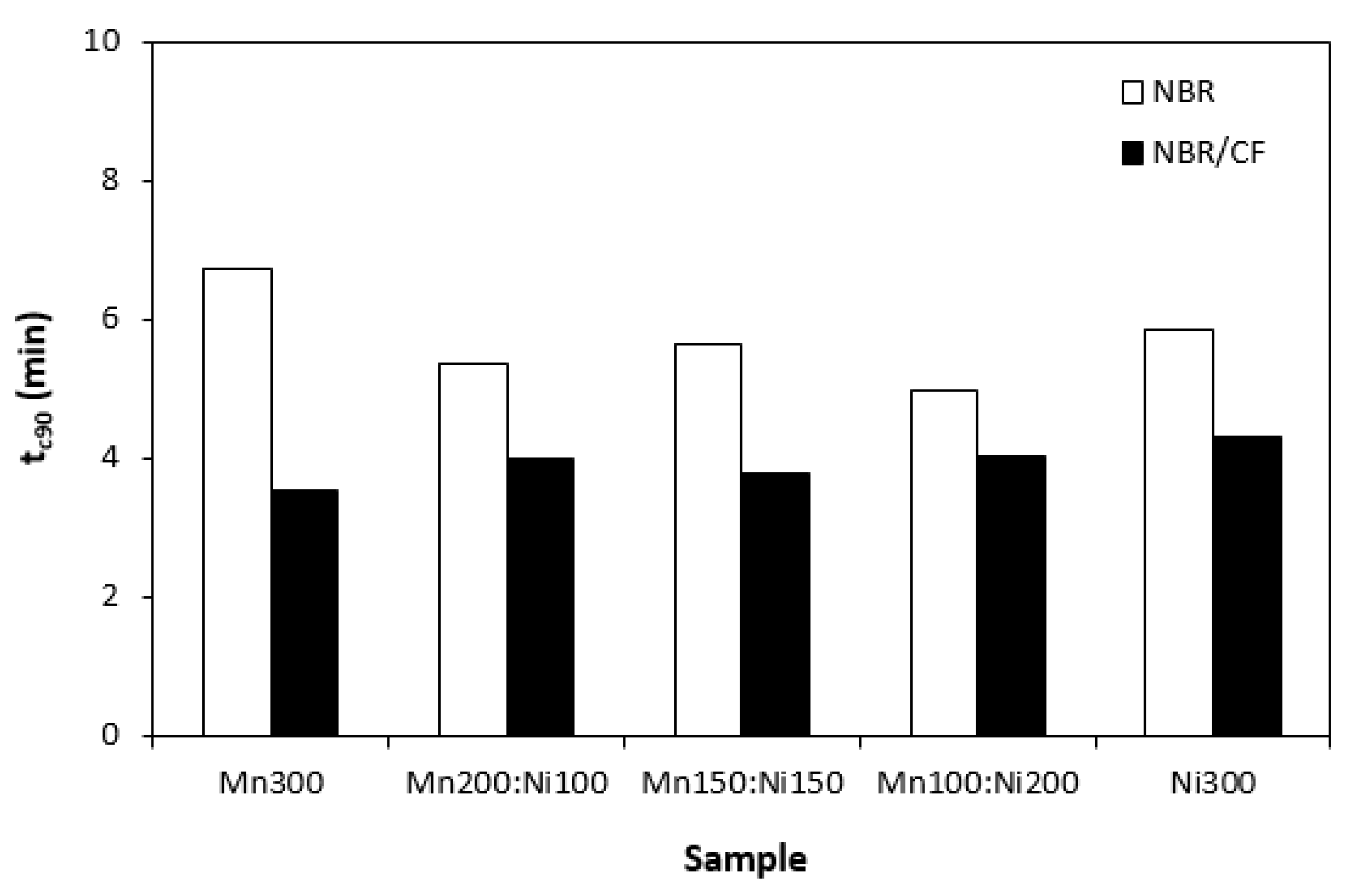
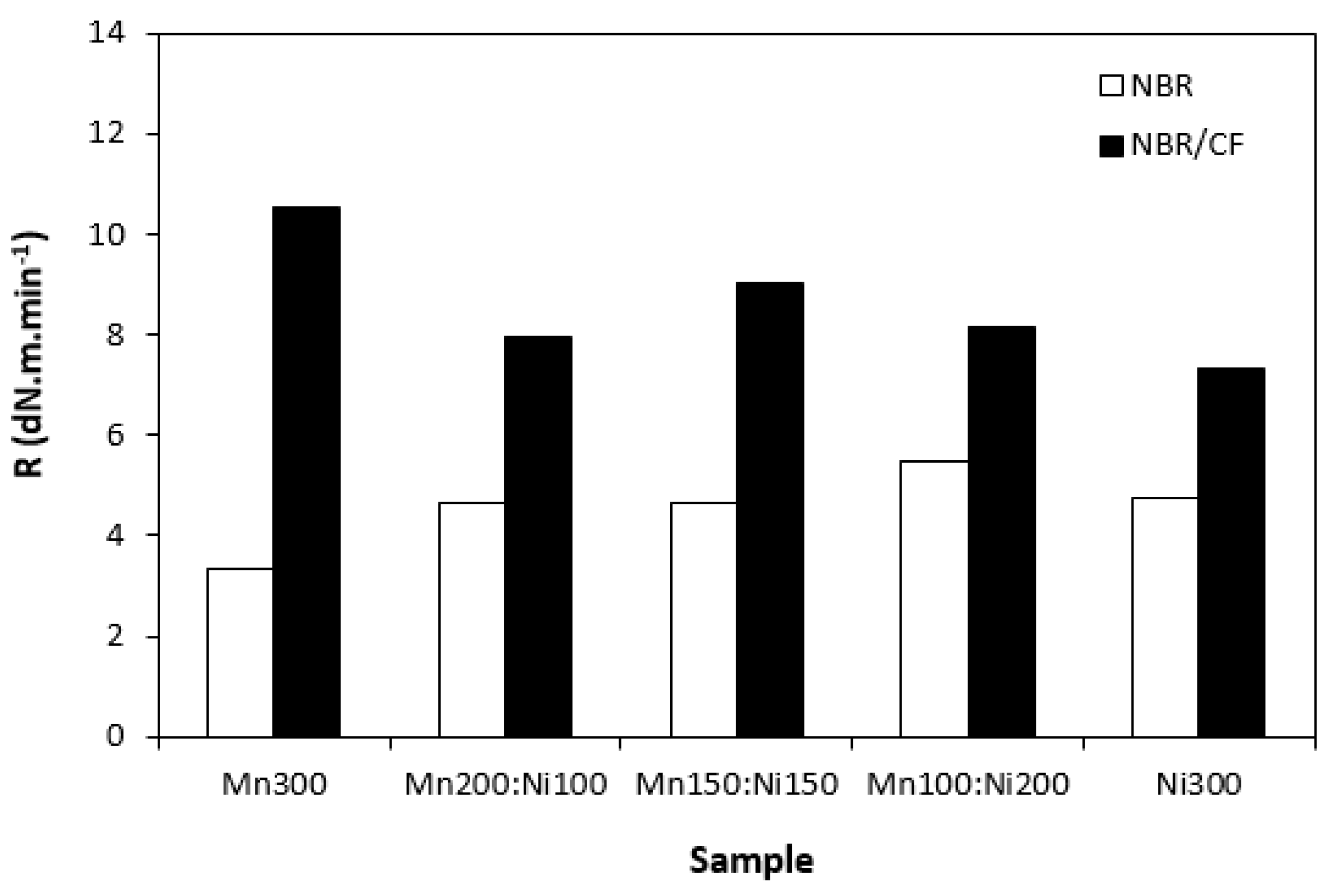

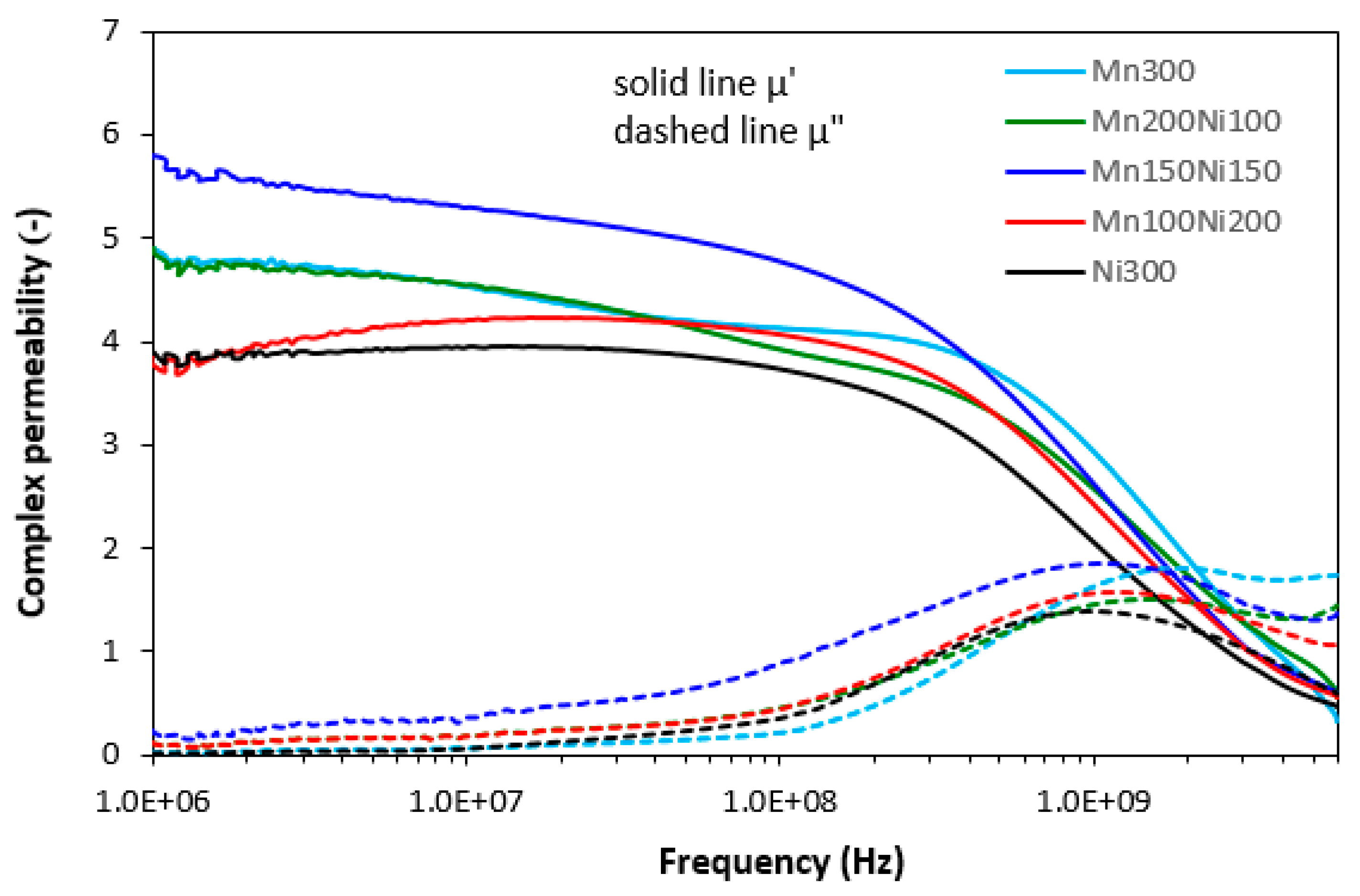

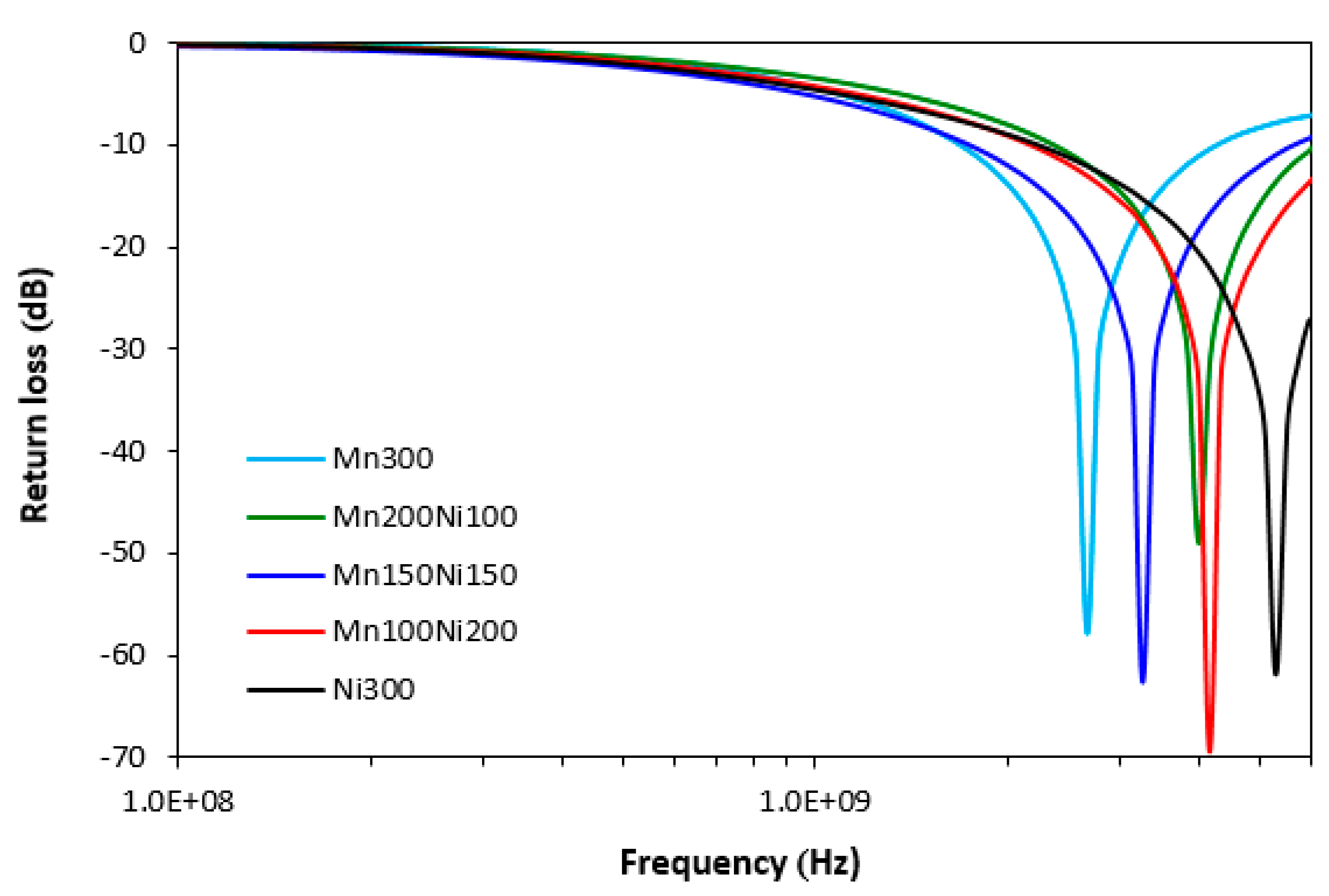
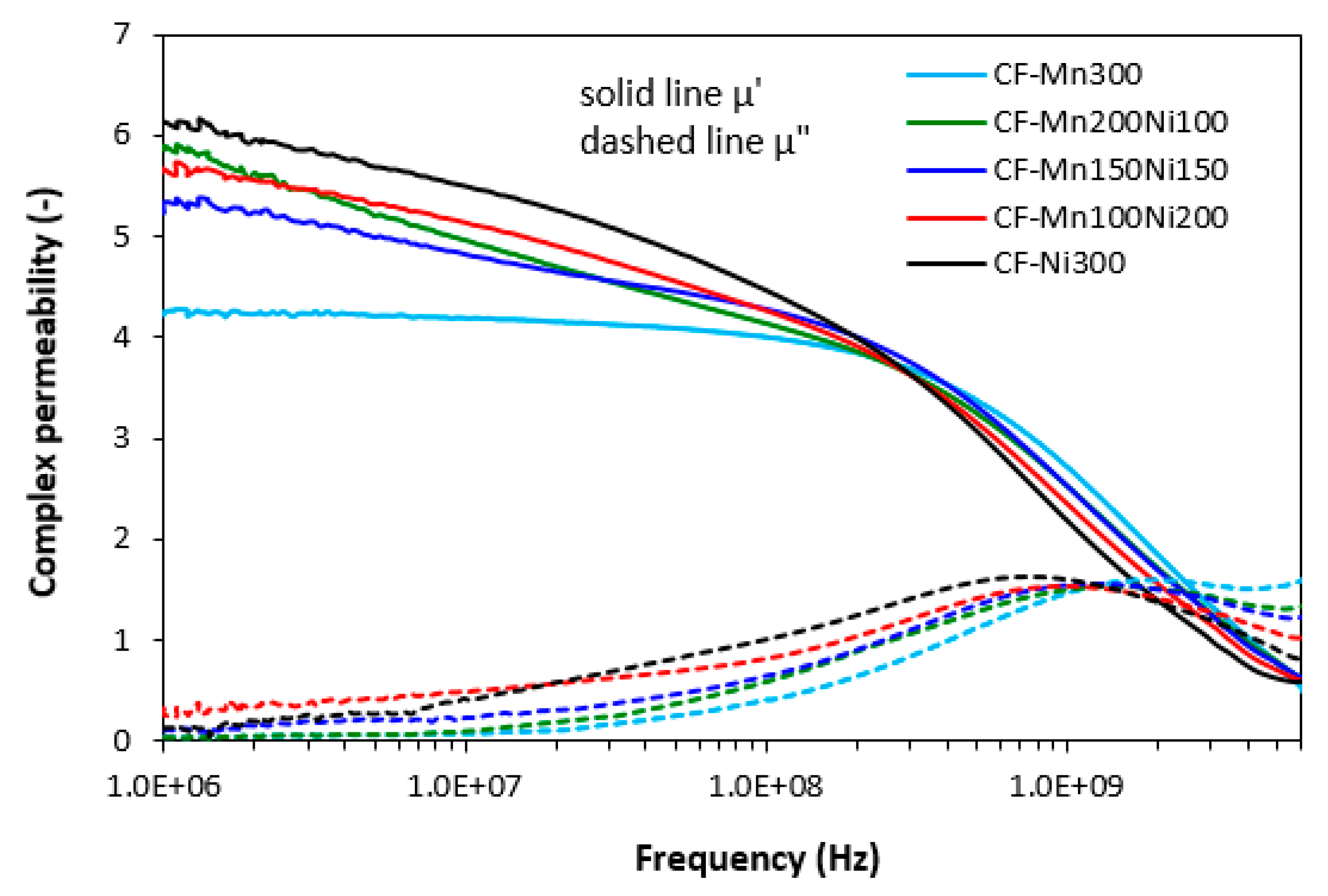
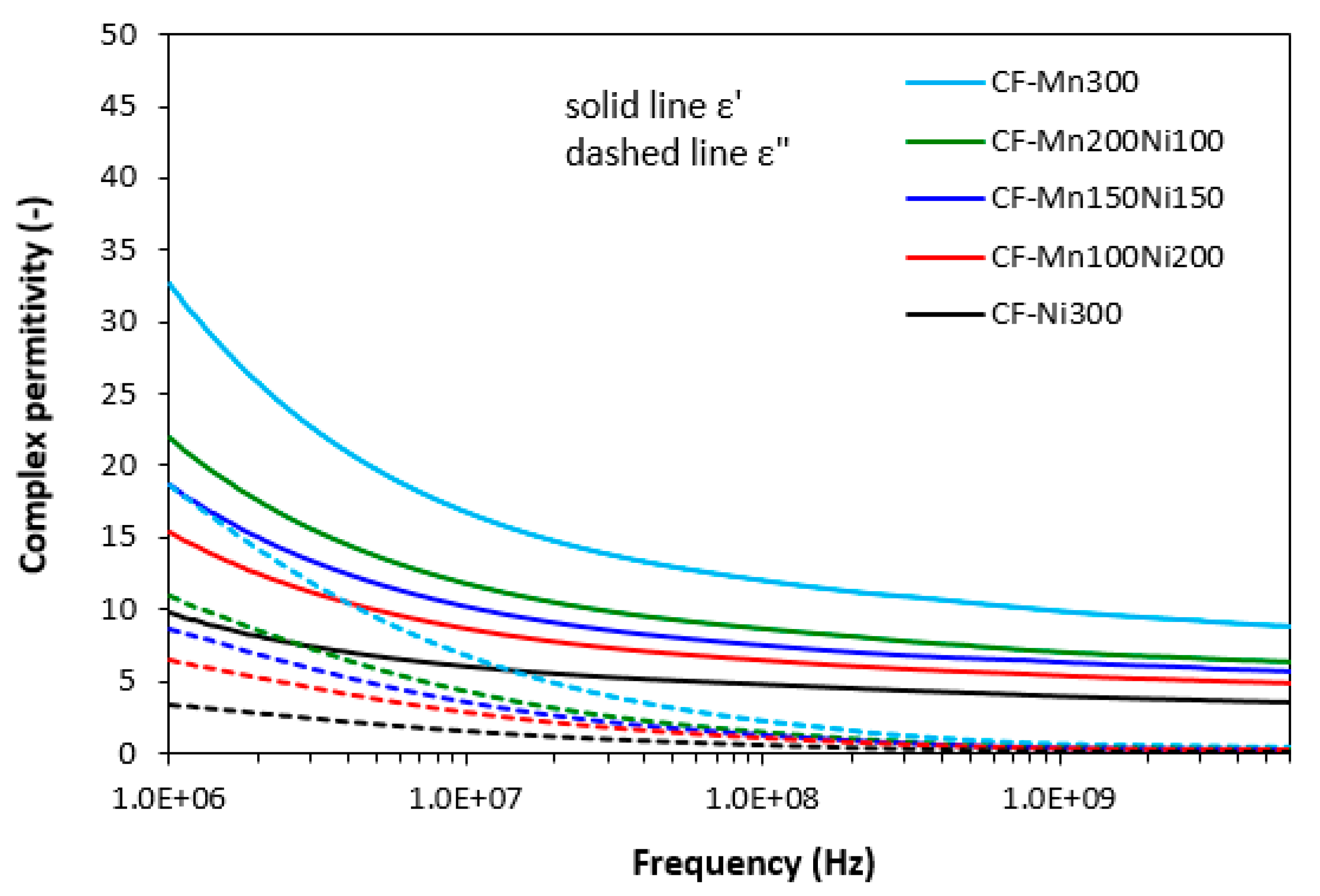
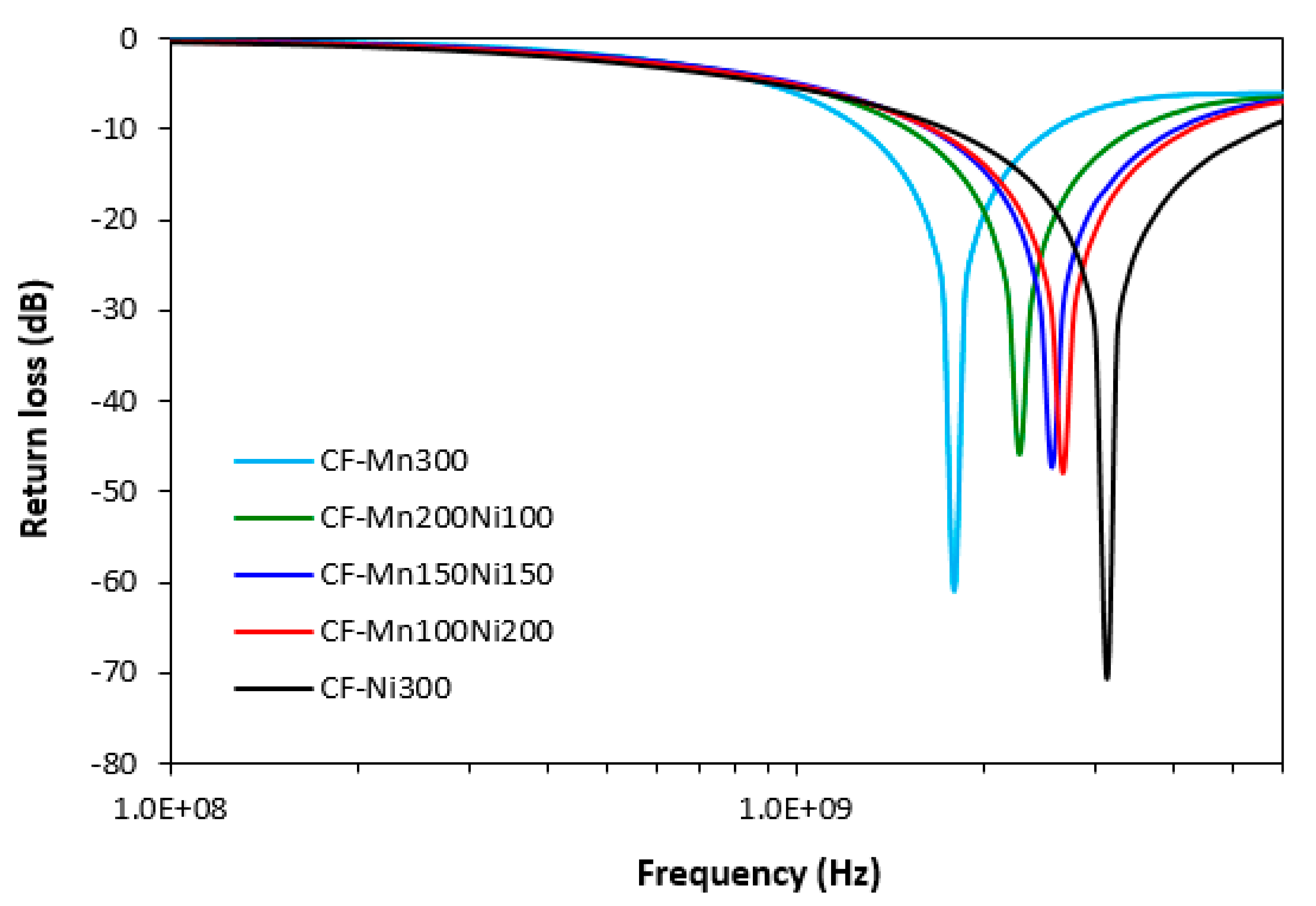
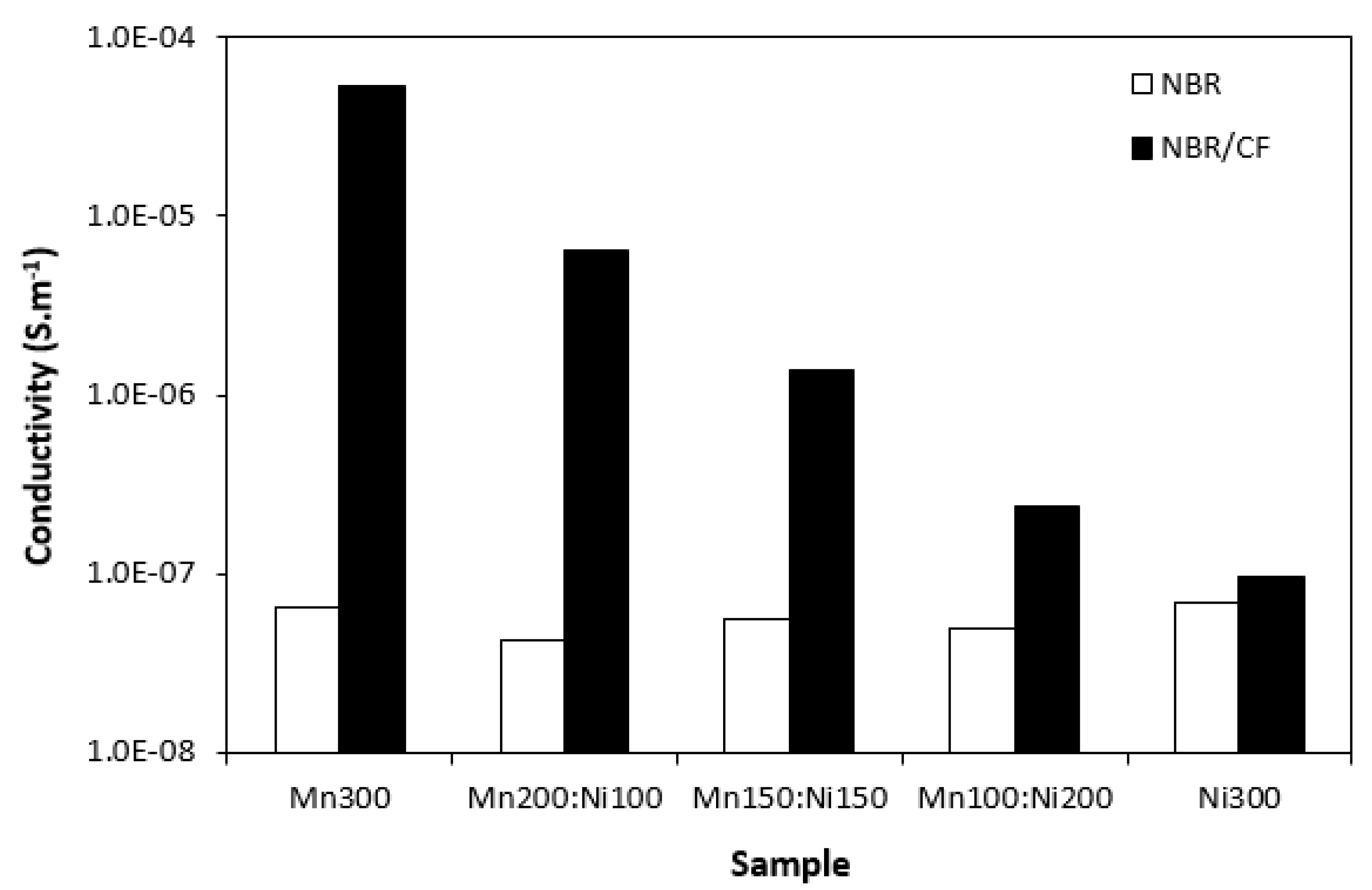

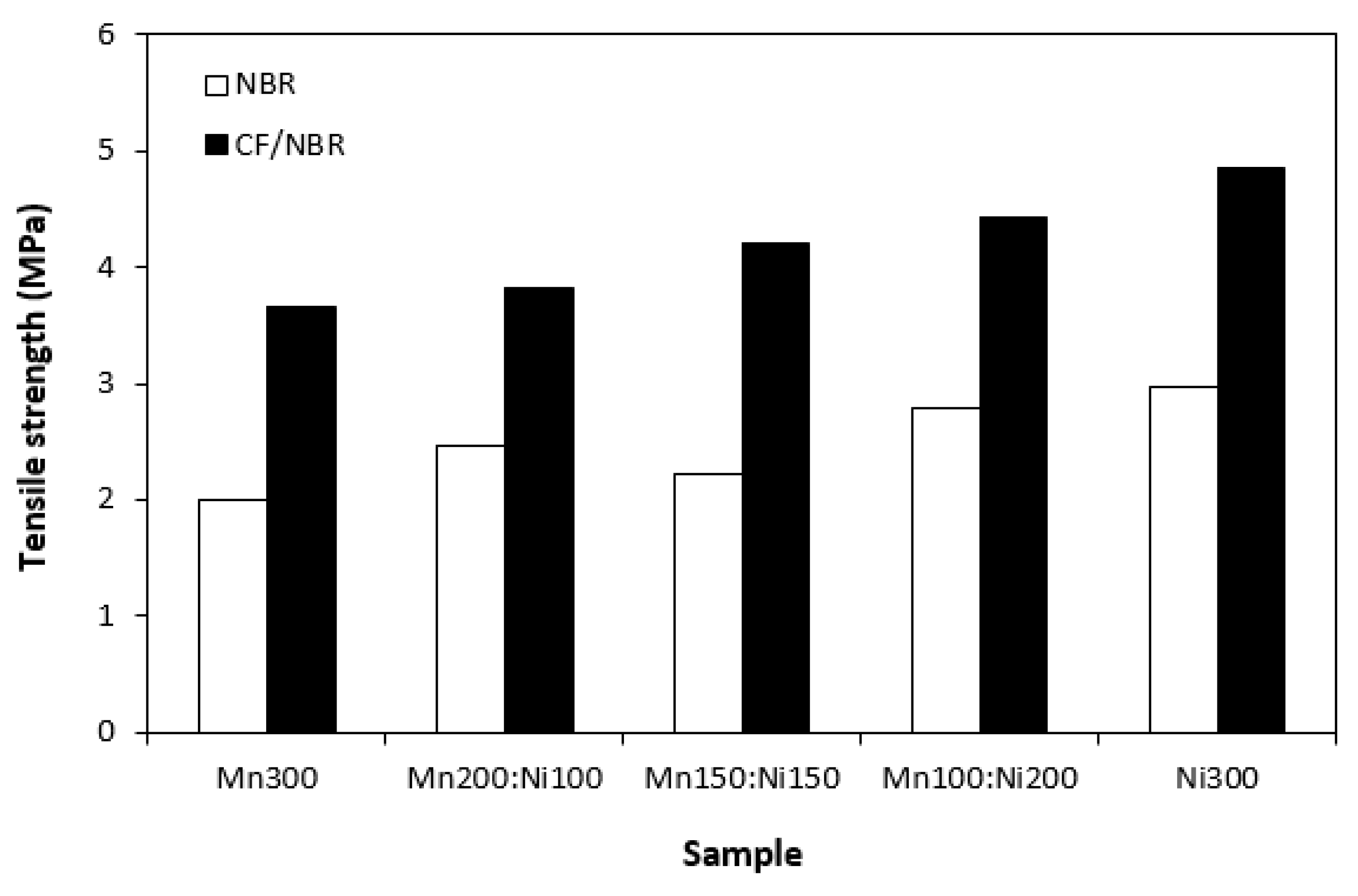

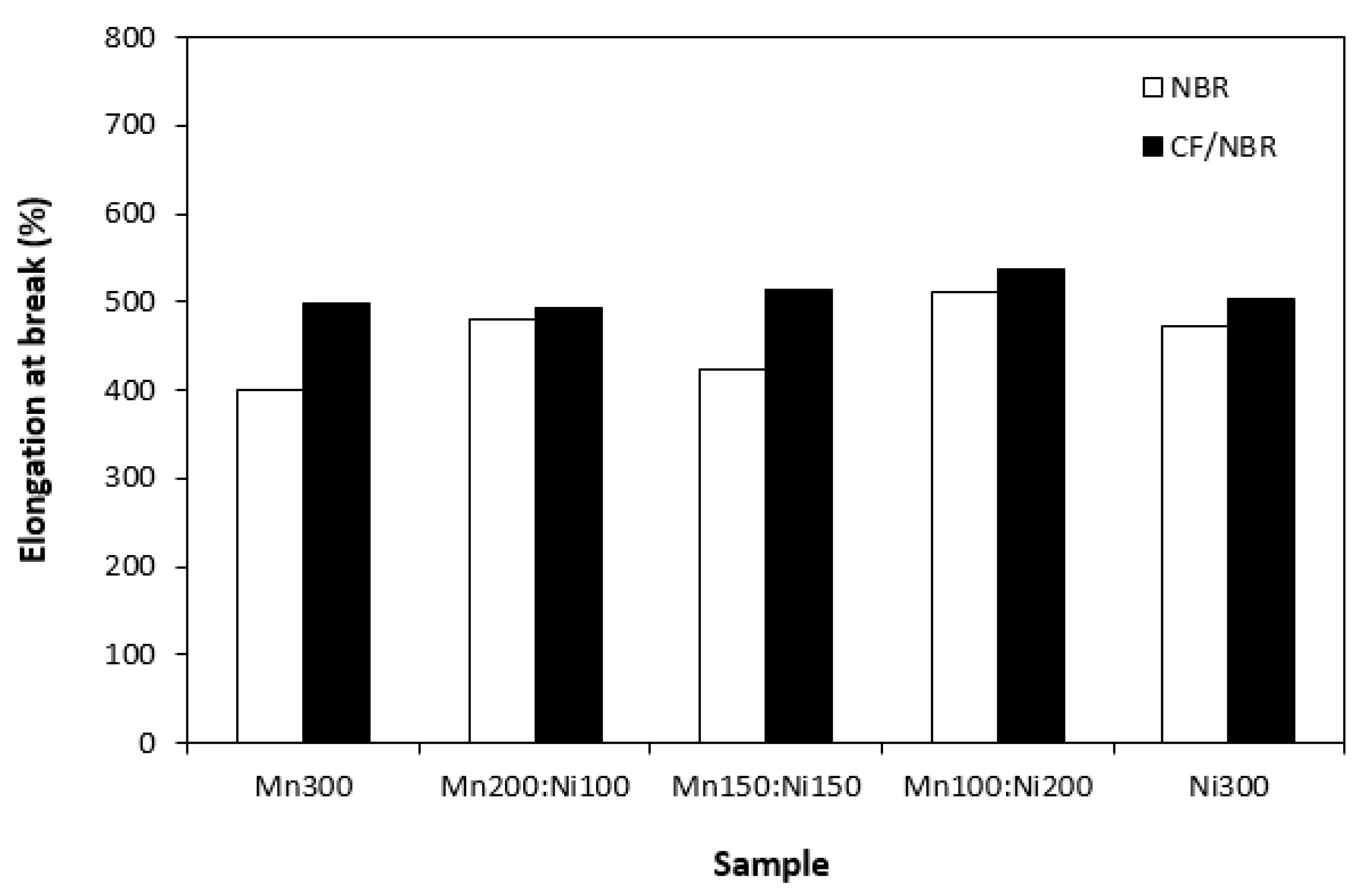
| Filler | Particle Size Distribution | D10 | D50 |
|---|---|---|---|
| MnZn | 0.7–50 μm | 4.7 μm | 16.3 μm |
| NiZn | 0.2–70 μm | 3.0 μm | 21.4 μm |
| NBR | 100 | 100 | 100 | 100 | 100 |
| ZnO | 3 | 3 | 3 | 3 | 3 |
| stearic acid | 2 | 2 | 2 | 2 | 2 |
| CBS | 1.5 | 1.5 | 1.5 | 1.5 | 1.5 |
| sulphur | 1.5 | 1.5 | 1.5 | 1.5 | 1.5 |
| MnZn ferrite | 300 | 200 | 150 | 100 | 0 |
| NiZn ferrite | 0 | 100 | 150 | 200 | 300 |
| designation | Mn300 | Mn200 Ni100 | Mn150 Ni150 | Mn100 Ni200 | Ni300 |
| NBR | 100 | 100 | 100 | 100 | 100 |
| ZnO | 3 | 3 | 3 | 3 | 3 |
| stearic acid | 2 | 2 | 2 | 2 | 2 |
| CBS | 1.5 | 1.5 | 1.5 | 1.5 | 1.5 |
| sulphur | 1.5 | 1.5 | 1.5 | 1.5 | 1.5 |
| Carbon fibres | 25 | 25 | 25 | 25 | 25 |
| MnZn ferrite | 300 | 200 | 150 | 100 | 0 |
| NiZn ferrite | 0 | 100 | 150 | 200 | 300 |
| designation | CF-Mn300 | CF-Mn200 Ni100 | CF-Mn150 Ni150 | CF-Mn100 Ni200 | CF-Ni300 |
| Sample | RLmin (dB) | fm (MHz) | Δf (MHz) −10 dB | Δf (MHz) −20 dB |
|---|---|---|---|---|
| Mn300 | −58 | 2660 | 2500 | 740 |
| Mn200Ni100 | −49 | 3980 | 3600 | 1160 |
| Mn150Ni150 | −63 | 3250 | 3800 | 1130 |
| Mn100Ni200 | −69 | 4140 | 3800 | 1530 |
| Ni300 | −62 | 5260 | 3750 | 2090 |
| Sample | RLmin (dB) | fm (MHz) | Δf (MHz) − 10 dB | Δf (MHz) − 20 dB |
|---|---|---|---|---|
| CF-Mn300 | −61 | 1783 | 1300 | 370 |
| CF-Mn200Ni100 | −46 | 2267 | 1950 | 540 |
| CF-Mn150Ni150 | −47 | 2556 | 2380 | 660 |
| CF-Mn100Ni200 | −48 | 2661 | 2650 | 740 |
| CF-Ni300 | −71 | 3130 | 3800 | 1080 |
Disclaimer/Publisher’s Note: The statements, opinions and data contained in all publications are solely those of the individual author(s) and contributor(s) and not of MDPI and/or the editor(s). MDPI and/or the editor(s) disclaim responsibility for any injury to people or property resulting from any ideas, methods, instructions or products referred to in the content. |
© 2023 by the authors. Licensee MDPI, Basel, Switzerland. This article is an open access article distributed under the terms and conditions of the Creative Commons Attribution (CC BY) license (https://creativecommons.org/licenses/by/4.0/).
Share and Cite
Kruželák, J.; Kvasničáková, A.; Džuganová, M.; Hašková, L.; Dosoudil, R.; Hudec, I. Curing, Properties and EMI Absorption Shielding of Rubber Composites Based on Ferrites and Carbon Fibres. Polymers 2023, 15, 857. https://doi.org/10.3390/polym15040857
Kruželák J, Kvasničáková A, Džuganová M, Hašková L, Dosoudil R, Hudec I. Curing, Properties and EMI Absorption Shielding of Rubber Composites Based on Ferrites and Carbon Fibres. Polymers. 2023; 15(4):857. https://doi.org/10.3390/polym15040857
Chicago/Turabian StyleKruželák, Ján, Andrea Kvasničáková, Michaela Džuganová, Lenka Hašková, Rastislav Dosoudil, and Ivan Hudec. 2023. "Curing, Properties and EMI Absorption Shielding of Rubber Composites Based on Ferrites and Carbon Fibres" Polymers 15, no. 4: 857. https://doi.org/10.3390/polym15040857





